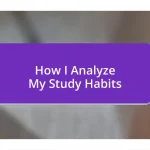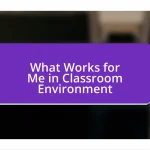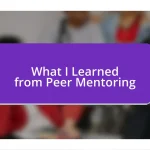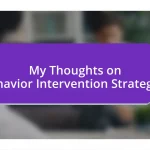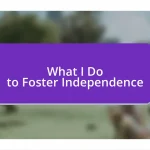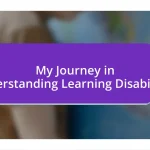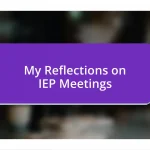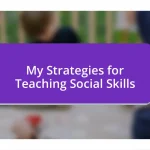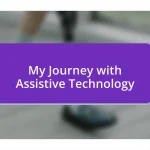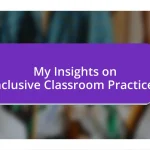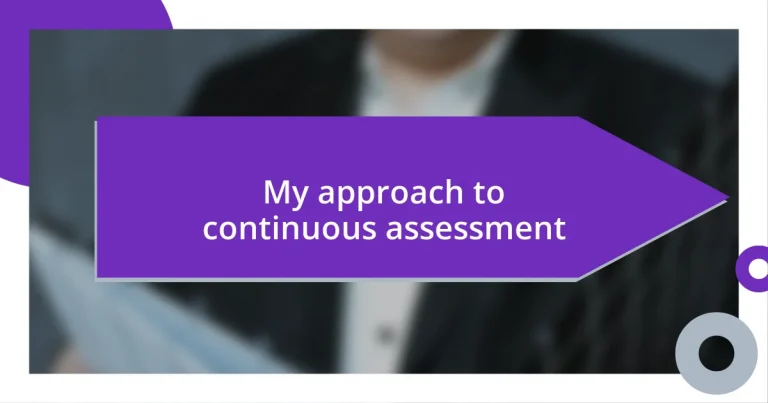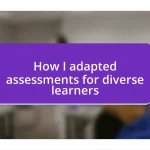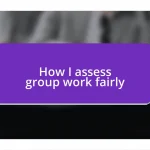Key takeaways:
- Continuous assessment fosters deeper student engagement and understanding by utilizing diverse evaluation methods such as quizzes, projects, and class participation.
- Timely and constructive feedback provides motivation and encourages students to reflect on their learning, enhancing ownership of their educational journey.
- Involving students in the assessment process through peer and self-assessments, as well as integrating technology, enriches their learning experience and fosters a supportive classroom environment.
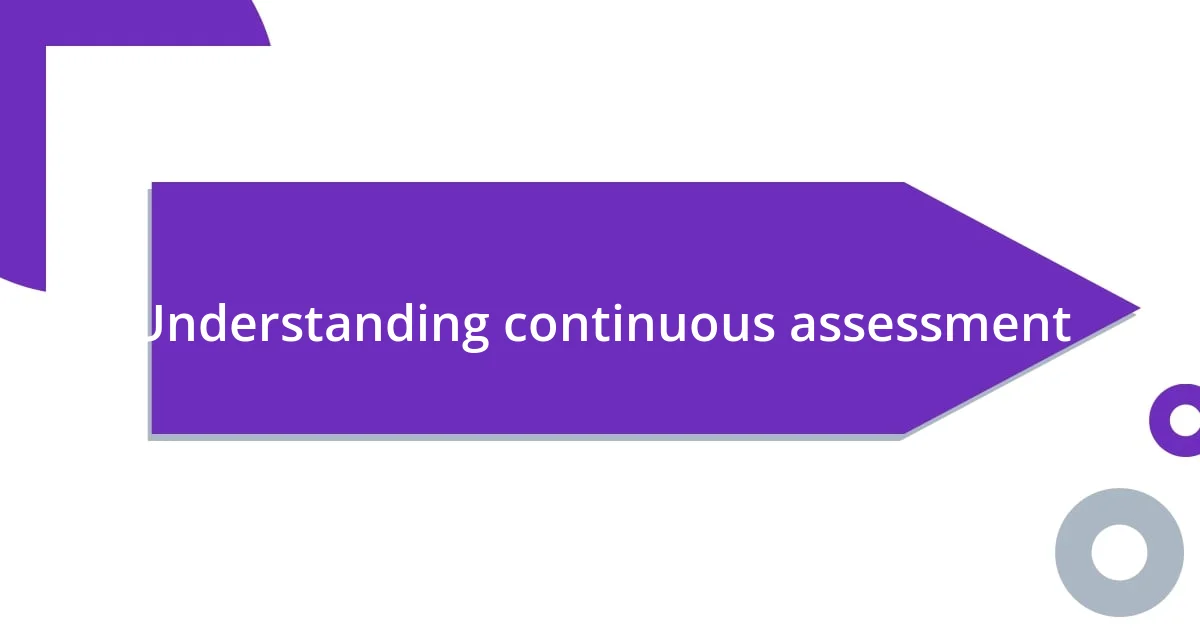
Understanding continuous assessment
Continuous assessment is an approach that evaluates student learning through various activities over time, rather than relying solely on a single exam. I remember a time in my teaching career when I transitioned to this method; it was a game-changer. Watching my students grow gradually, rather than just seeing their nervous faces during a final exam, filled me with a sense of hope and excitement.
Have you ever felt the pressure of one big test defining your entire understanding of a subject? Continuous assessment alleviates that anxiety. By incorporating quizzes, projects, and class participation as part of the grading process, I noticed not just a deeper understanding from my students, but also a more significant engagement in their learning. They were no longer just cramming but rather absorbing knowledge, which is truly gratifying to witness.
This method also allows for timely feedback, creating opportunities for students to improve. In my experience, I’ve seen those “aha” moments come alive during informal assessments, where students could discuss their misconceptions openly. It’s about cultivating an environment where learning is an ongoing journey rather than a destination, and I find that incredibly fulfilling for both myself and my students.
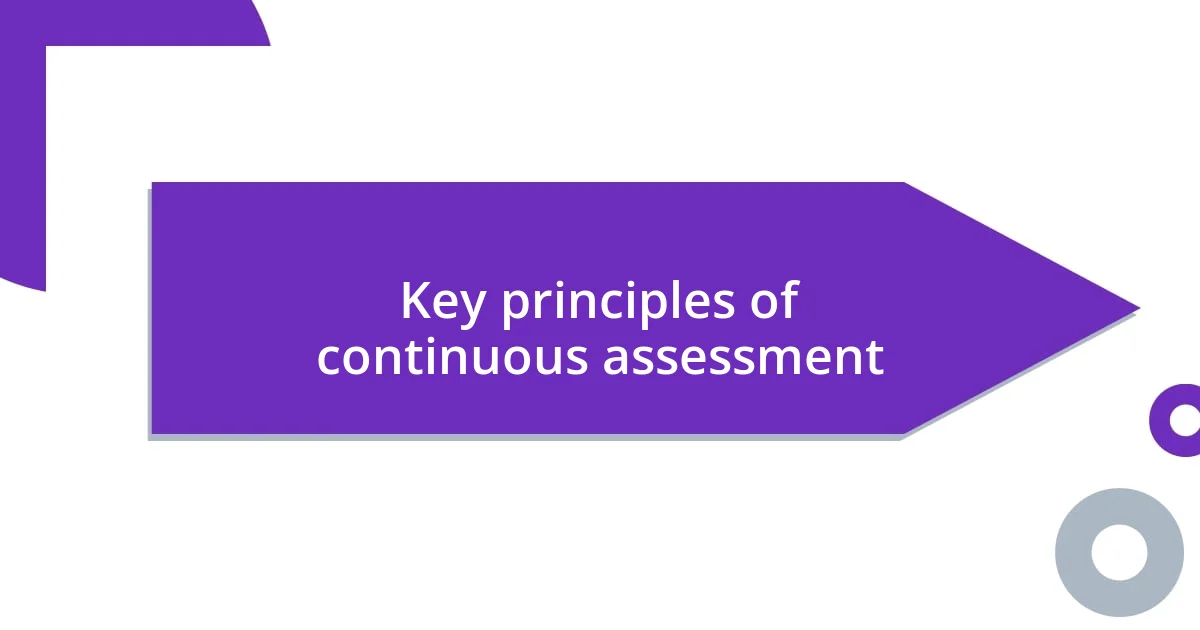
Key principles of continuous assessment
The essence of continuous assessment lies in several key principles that create a supportive and enriching learning environment. For me, one of the most vital principles is the focus on formative feedback. I recall how a simple comment on a student’s draft had the power to inspire them to dig deeper into their analysis. Feedback should be constructive and prompt students to reflect on their learning process, guiding them toward improvement.
Here are some key principles that I believe are essential for successful continuous assessment:
- Holistic Evaluation: It’s not just about grades; the journey of learning matters.
- Frequent Checkpoints: Regular assessments keep students engaged and informed about their progress.
- Flexible Design: Assessments should adapt to different learning styles, allowing every student to shine.
- Collaborative Learning: Encouraging peer assessments fosters a sense of community and collective growth.
I’ve found that when students feel supported and see their growth reflected in continuous feedback, their motivation to learn significantly increases. It’s a rewarding experience for me as an educator to witness this transformation.
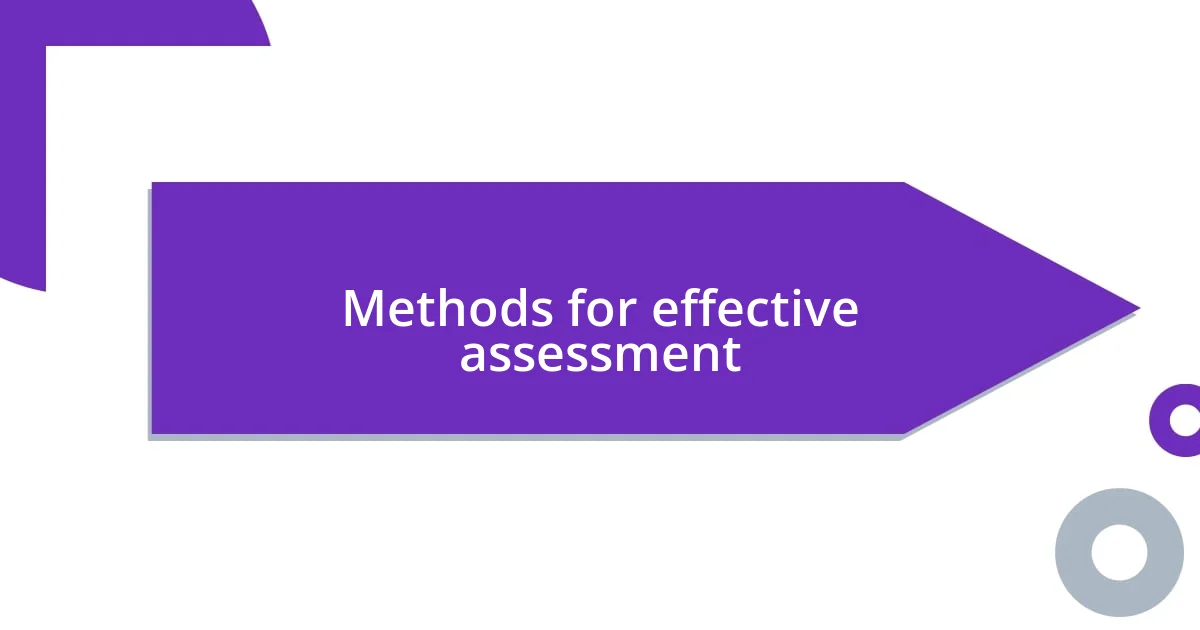
Methods for effective assessment
To assess effectiveness, employing various methods can greatly enhance student learning. In my experience, incorporating peer assessments has proven invaluable. There’s something remarkable about students evaluating one another; it not only bolsters their critical thinking skills but fosters a deeper connection among peers. I’ve often watched my students beam with pride when they provide feedback to their classmates, as it gives them ownership over their learning process.
Another method I’ve utilized is incorporating self-assessment. I recall an instance when I introduced reflective journals in a course; the transformation I observed was incredible. Students began to articulate their thoughts and feelings about their learning journey, which deepened their understanding of the material. They didn’t just see grades; they recognized their growth, grappled with challenges, and celebrated their achievements.
Lastly, technology can be a great ally in effective assessment. By using online quizzes and interactive platforms, I can provide instant feedback to my students. This immediacy not only keeps them informed but also engaged, turning assessments into learning opportunities rather than just evaluation tools. Have you ever experienced that immediate satisfaction when you get feedback on something you’ve worked hard on? It really makes a difference in how we view our progress.
| Method | Description |
|---|---|
| Peer Assessment | Allows students to evaluate each other’s work, fostering collaboration and critical thinking. |
| Self-Assessment | Encourages students to reflect on their learning through journals or portfolios, promoting personal growth. |
| Technology Integration | Utilizes online tools for instant feedback, enhancing engagement and learning opportunities. |
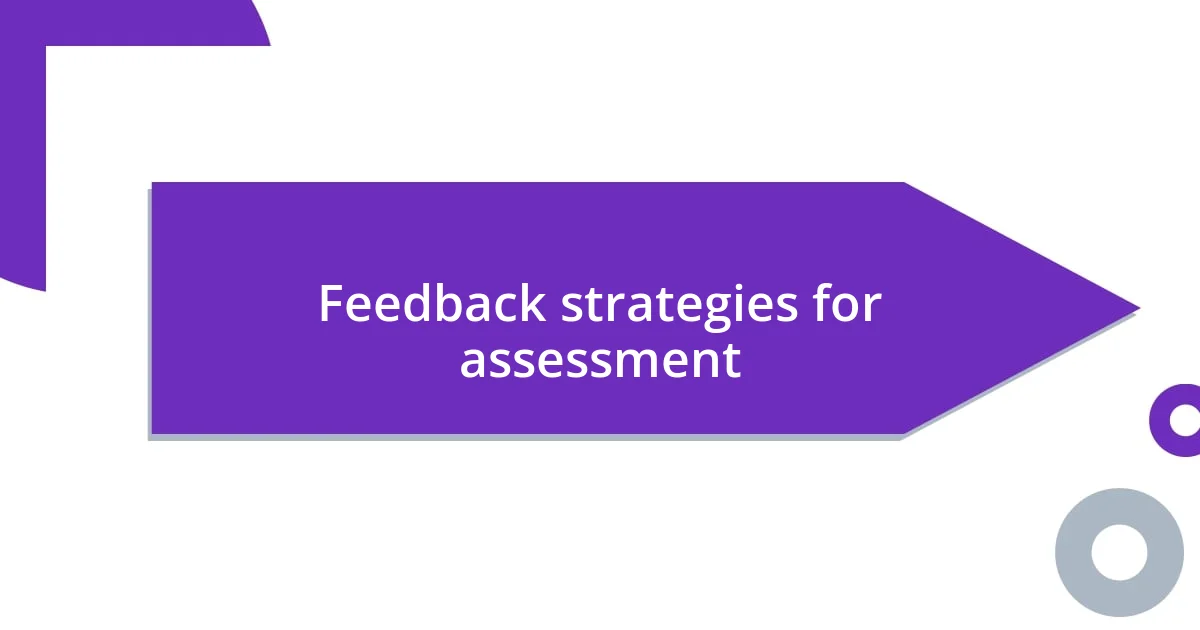
Feedback strategies for assessment
When I think about feedback strategies for assessment, I can’t help but remember a poignant moment in my classroom. One student, despite struggling with public speaking, received specific feedback on their presentation style that highlighted their strengths. The joy on their face when they realized they could improve was electrifying; it really drove home how crucial targeted, strengths-based feedback can be. I’ve often wondered: how do we sometimes overlook the power of positivity?
In my practice, I’ve found that timely feedback can dramatically shift a student’s learning trajectory. You know that feeling when you receive immediate responses? It’s exhilarating! I’ve adopted a practice of giving quick verbal feedback during presentations. I can see students visibly relax, and this tactic often sparks a beneficial dialogue about their performance, reinforcing their confidence and understanding without the intimidating barrier of grades.
Moreover, I always encourage my students to set personal goals based on feedback. It’s fascinating to observe how these goals become touchstones for their progress. I recall a student who set a goal to enhance their writing by focusing on clarity. With consistent feedback, their work evolved beautifully, and that spark of determination was infectious. It begs the question: how can we make goal-setting a more integral part of our feedback process? In my experience, it’s about making feedback a conversation rather than a monologue, allowing students to take ownership of their growth.
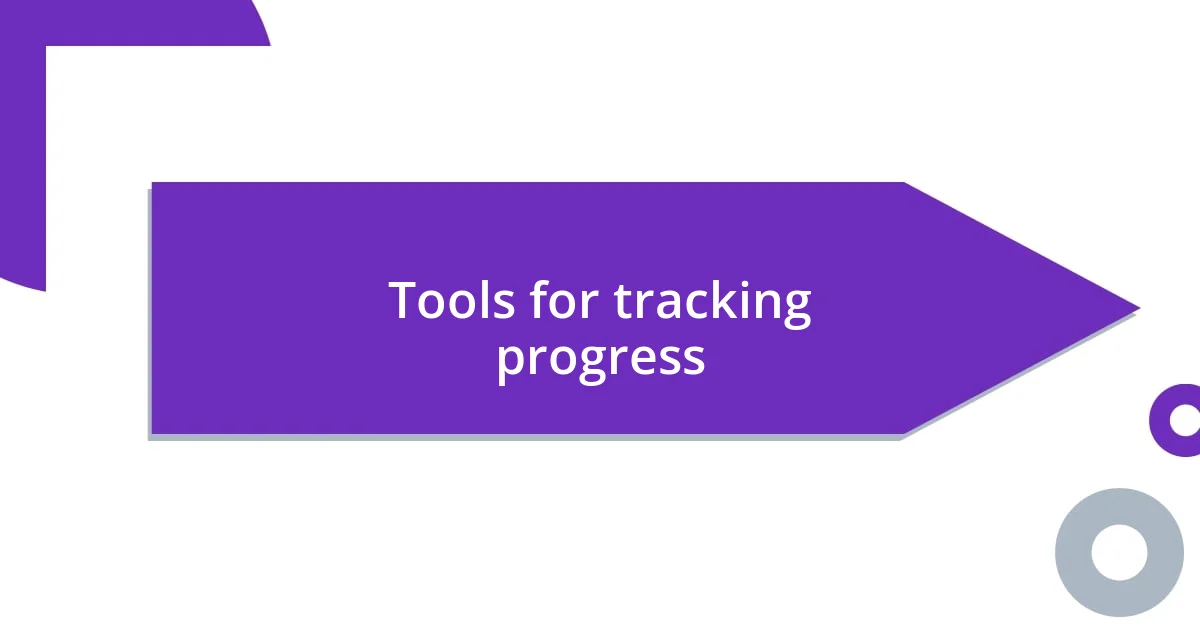
Tools for tracking progress
When it comes to tracking progress, I’ve personally found that using digital portfolios makes an enormous difference. I remember the first time I introduced them in my classroom; students would upload their best work and reflect on their learning journey over time. Being able to visibly see how far they’ve come sparked conversations that were rich with emotion and anticipation for future growth. It made the learning process feel tangible, almost like they were curating their own success stories.
Another tool I’ve relied on is formative assessments, like quick polls or exit tickets. I was amazed at how a simple five-minute activity at the end of a lesson could reveal what students truly grasped or struggled with. Just last week, I used an exit ticket to gauge understanding of a complex topic, and it uncovered a misconception that I hadn’t even realized was pervasive. It reminded me of the importance of staying in tune with students’ thought processes; sometimes their confusion can become our greatest teaching opportunity.
Finally, I’ve integrated performance tracking apps that allow students to monitor their progress in real-time. I introduced one during a writing unit, and it was fascinating to observe students’ reactions as they could literally see their improvement in data charts. They felt a sense of ownership over their learning, and it made me wonder: how often do we give students the chance to visualize their progress? In my experience, when they actively engage with the tools they use, they seem more motivated and eager to continue their learning journey.
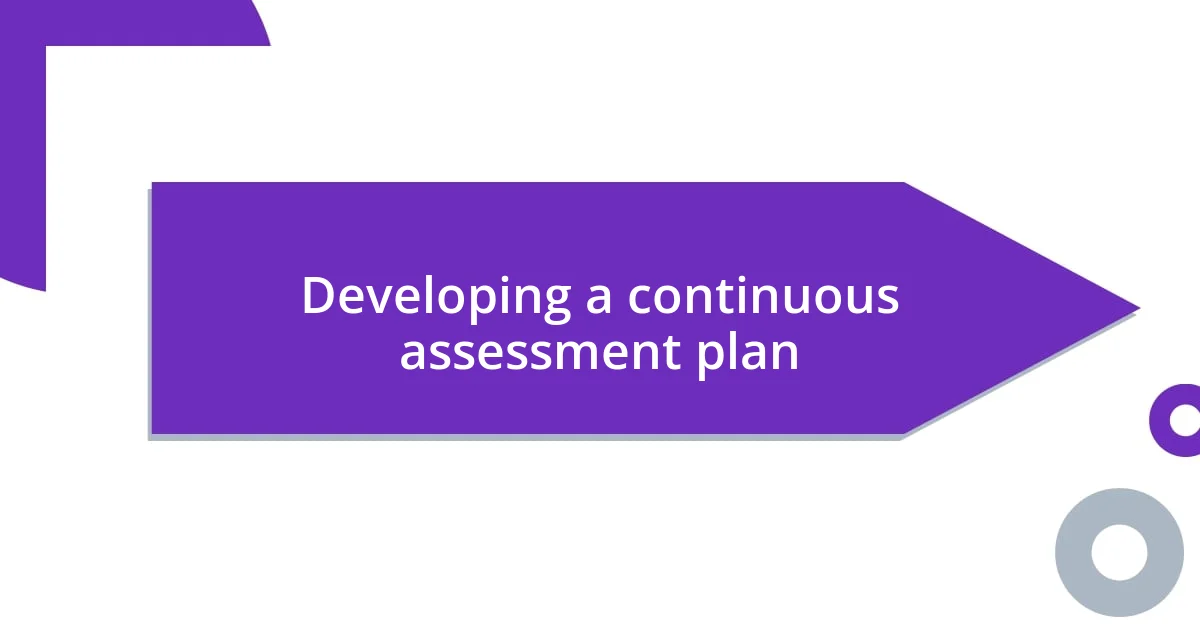
Developing a continuous assessment plan
When developing a continuous assessment plan, I find it crucial to start with clear objectives. I once faced a challenge when my goals for a writing unit weren’t specific enough, resulting in confusion among my students about what they were expected to achieve. By defining measurable outcomes, such as enhancing their vocabulary or improving clarity, I noticed students felt more directed and focused, almost like when you finally get a map on a long trek—you know where you’re headed!
Another key aspect is collaboration with students in the assessment process. I remember introducing peer reviews and was initially unsure of how my students would respond. To my surprise, they embraced it wholeheartedly, often providing insights that I hadn’t considered. This shared responsibility turned assessments into vibrant discussions rather than mere evaluations. Doesn’t it make you wonder how often we overlook the value of student input in shaping their learning paths?
Lastly, integrating a variety of assessment methods keeps the process dynamic and engaging. I once experimented with a mix of projects, presentations, and quizzes for a history unit. This approach not only showcased different talents but also allowed students to reflect on their learning styles. I observed that those who typically struggled with traditional exams shone brightly in creative projects. How empowering it is for students to demonstrate their knowledge in ways that resonate with them! The richness of their learning experience simply cannot be overstated.
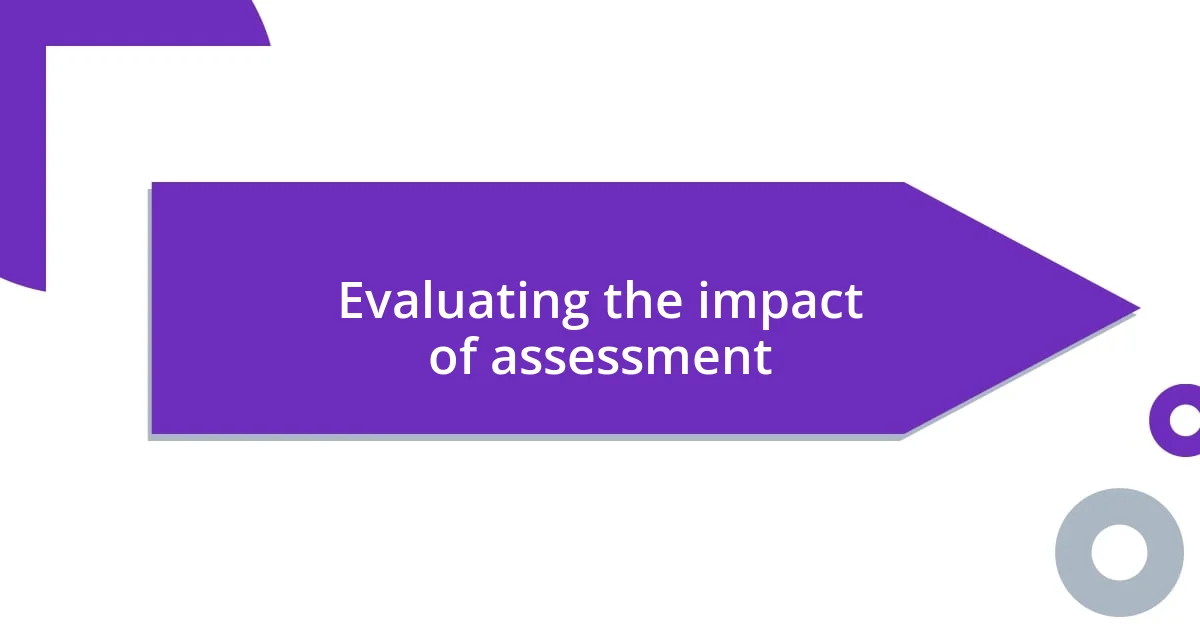
Evaluating the impact of assessment
Assessing the impact of our evaluation methods is crucial for my growth as an educator. I remember a particular semester where I shifted my focus to student feedback on assessments. After implementing a brief survey asking for their thoughts on the assessments’ effectiveness, I was startled by their candid responses. They highlighted aspects I hadn’t considered, like the pacing of tests and the clarity of instructions. It made me realize that involving students in the evaluation process isn’t just about gathering data; it’s about constructing a more inclusive learning atmosphere.
On another occasion, I introduced a reflective journaling component where students could articulate their feelings about their learning experiences. It was eye-opening to see how their emotions impacted their academic performance. For instance, students who expressed anxiety about tests often underperformed, while those who felt supported thrived. This subtle shift in perspective shifted my approach to assessments—offering a more holistic understanding of their impact. I’ve learned that emotional insights can drive our strategies; shouldn’t we always consider how our assessments affect our students beyond just the grades?
I’ve also found success in analyzing trends in the results of my assessments. One year, I noticed a consistent dip in scores on particular topics across multiple classes. Instead of blaming the students, I took it as a sign to reevaluate my teaching methods. Watching my class engage with a revamped, interactive lesson on that topic was incredibly rewarding. Their excitement and understanding were palpable, proving that assessment isn’t merely a reflection of learning; it’s a lens through which we can enhance the overall educational journey. Isn’t it fascinating how a single insight can spark such transformational change in our teaching?
